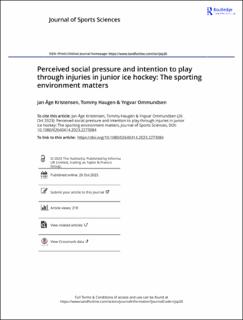| dc.contributor.author | Kristensen, Jan Åge | |
| dc.contributor.author | Haugen, Tommy | |
| dc.contributor.author | Ommundsen, Yngvar | |
| dc.date.accessioned | 2024-01-05T08:42:16Z | |
| dc.date.available | 2024-01-05T08:42:16Z | |
| dc.date.created | 2023-10-28T17:05:03Z | |
| dc.date.issued | 2023 | |
| dc.identifier.citation | Journal of Sports Sciences. 2023, 41(14), Side 1363-1371. | en_US |
| dc.identifier.issn | 0264-0414 | |
| dc.identifier.uri | https://hdl.handle.net/11250/3110022 | |
| dc.description | This is an Open Access article distributed under the terms of the Creative Commons Attribution License (http://creativecommons.org/licenses/by/4.0/), which permits unrestricted use, distribution, and reproduction in any medium, provided the original work is properly cited. The terms on which this article has been published allow the posting of the Accepted Manuscript in a repository by the author(s) or with their consent. | en_US |
| dc.description.abstract | Playing when injured is a risky yet common business among ice hockey players. Conceptualized within the framework of the theory of planned behaviour, the current cross-sectional study aimed to test a multiple-mediator model linking players’ perceived social pressure to their intention to play when injured. We tested whether social pressure is directly and indirectly (via attitudes, subjective norms, perceived behavioural control avoidance, and situational temptation) related to intention to play when injured. We recruited 186 junior players aged 16–20 years (mean age = 17.85; standard deviation = 1.35) from two Norwegian ice hockey leagues (under 18 and under 20 years of age). The data were analysed using a linear regression procedure and a bias-corrected bootstrapping technique to measure indirect effects. The results revealed a positive direct and indirect (via attitudes, subjective norms, and situational temptation) relationship between players’ perceived social pressure and their intention to play when injured. In conclusion, players that perceived pressure to play despite being injured, who perceived positive consequences of doing so, who believed that people close or important to them approved of them doing so, and who perceived game-specific temptations, were more likely to report a stronger intent to play the game when injured. | en_US |
| dc.language.iso | eng | en_US |
| dc.subject | athletes | en_US |
| dc.subject | coaching | en_US |
| dc.subject | injury | en_US |
| dc.subject | pain | en_US |
| dc.subject | theory of planned behaviour | en_US |
| dc.subject | youth | en_US |
| dc.title | Perceived social pressure and intention to play through injuries in junior ice hockey: The sporting environment matters | en_US |
| dc.type | Peer reviewed | en_US |
| dc.type | Journal article | en_US |
| dc.description.version | publishedVersion | en_US |
| dc.rights.holder | © 2023 The Author(s) | en_US |
| dc.source.pagenumber | 1363-1371 | en_US |
| dc.source.volume | 41 | en_US |
| dc.source.journal | Journal of Sports Sciences | en_US |
| dc.source.issue | 14 | en_US |
| dc.identifier.doi | 10.1080/02640414.2023.2273084 | |
| dc.identifier.cristin | 2189524 | |
| dc.description.localcode | Institutt for idrett og samfunnsvitenskap / Department of Sport and Social Sciences | en_US |
| cristin.ispublished | true | |
| cristin.fulltext | original | |
| cristin.qualitycode | 2 | |
